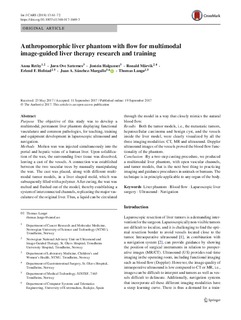| dc.description.abstract | Purpose The objective of this study was to develop a multimodal, permanent liver phantom displaying functional vasculature and common pathologies, for teaching, training and equipment development in laparoscopic ultrasound and navigation. Methods Molten wax was injected simultaneously into the portal and hepatic veins of a human liver. Upon solidification of the wax, the surrounding liver tissue was dissolved, leaving a cast of the vessels. A connection was established between the two vascular trees by manually manipulating the wax. The cast was placed, along with different multimodal tumor models, in a liver shaped mold, which was subsequently filled with a polymer. After curing, the wax was melted and flushed out of the model, thereby establishing a system of interconnected channels, replicating the major vasculature of the original liver. Thus, a liquid can be circulated through the model in a way that closely mimics the natural blood flow. Results Both the tumor models, i.e., the metastatic tumors, hepatocellular carcinoma and benign cyst, and the vessels inside the liver model, were clearly visualized by all the three imaging modalities: CT, MR and ultrasound. Doppler ultrasound images of the vessels proved the blood flow functionality of the phantom. Conclusion By a two-step casting procedure, we produced a multimodal liver phantom, with open vascular channels, and tumor models, that is the next best thing to practicing imaging and guidance procedures in animals or humans. The technique is in principle applicable to any organ of the body. | nb_NO |

